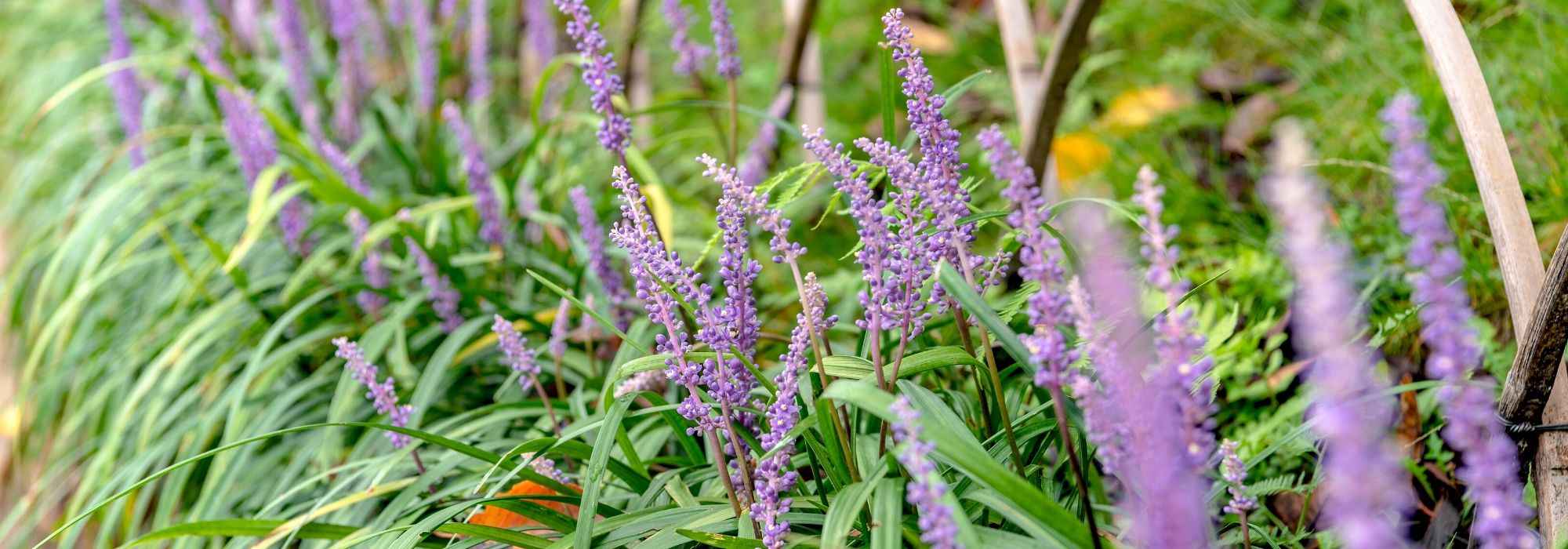
Liriope: planting, growing, propagating
Contents
Liriope in a nutshell
- Liriope (Liriope muscari and spicata) is an excellent elegant, evergreen groundcover for shaded areas of the garden, even under trees
- It grows in small clumps of strap-like foliage, either solid or variegated, reminiscent of grasses
- This woodland perennial displays tight spikes of mauve, blue-lilac, or white flowers from late summer to autumn
- It is a virtually maintenance-free plant that tolerates almost any type of well-drained soil, with a preference for cool soils
- It naturalises easily and also provides very effective protection against weeds, gradually smothering them
A word from our expert
The Liriope is a hardy bulbous perennial that slowly forms an evergreen groundcover, in the shaded areas of the garden, even under trees, and in dry shade.
It forms dense clumps resembling small grasses with strap-like foliage, which are adorned in summer by lovely blue-mauve or white spikes.
There are 6 species, including Liriope spicata, and Liriope muscari, which is the most well-known of them all. Among the cultivars of Liriope muscari, we particularly appreciate the Liriope muscari ‘Ingwersen’ with lavender flowers, Liriope muscari ‘Monroe white’ with white flowers, Liriope muscari ‘Royal Purple’, and Liriope muscari ‘Variegata’ with variegated foliage.
Very hardy and low-maintenance, plant it in well-drained, humus-bearing, slightly acidic soil. It will elegantly dress the base of trees, borders, fresh beds, a shaded rockery, and even pots.
Discover our collection of Liriopes in pots to flower your garden from the very first year of cultivation.
Description and Botany
“`html
Botanical data
- Latin name Liriope
- Family Liliaceae
- Common name Liriope, Common Liriope
- Flowering from June to October, depending on the climate
- Height 0.15 to 0.45 m
- Exposure Partial shade, Shade
- Soil type Draining, light, humus-bearing
- Hardiness below -15°C
The Liriope is a hardy, rhizomatous perennial belonging to the Liliaceae (Asparagaceae) family, native to Asia, particularly China and Japan, where it grows in moist woods, open forests, and bamboo groves.
The Liriope genus comprises about 6 species, the most well-known of which is the Liriope muscari, which has given rise to numerous cultivars diversifying the colour palette, such as Liriope muscari ‘Ingwersen’ and Liriope muscari ‘Monroe White’. Less common, Liriope spicata is distinguished by its finer, narrower foliage, pale mauve flowers, and lower habit.
Growing rather slowly, it forms from a slightly running rootstock small, low, compact clumps measuring 30 to 45 cm in all directions. Due to its tufted rootstock, it is never invasive. Liriope naturalises easily to cover the ground in partial shade. Like Ophiopogon, with which it is closely related, it can establish itself at the edges and under trees, in areas often neglected by other plants.
This plant forms a persistent groundcover with beautiful strap-like foliage reminiscent of grasses due to its fineness and narrowness. The fine, linear, ribbon-like, and leathery leaves are 8 to 15 cm long and 1 to 2 cm wide, folded in the middle. They emerge in tight clumps from a short rhizome. Medium to very dark green in the typical species, depending on the varieties, they can be variegated or marginate with green and cream or golden yellow (‘Variegata’).
Throughout the summer, from June to October, depending on the climate, flowering spikes emerge from this graphic tuft of foliage, borne on long, thread-like, tubular stems. Liriope displays beautiful upright spikes gathered in short terminal clusters. They consist of numerous small bell-shaped flowers with 6 waxy tepals grouped in clusters of 3 to 8 on short pedicels.
They come in shades of blue-violet, lilac mauve, and lavender in Liriope ‘Gold Banded’. Liriope muscari ‘Monroe White’ stands out with white flowers that contrast with the dark foliage. These spikes resemble those of muscaris, hence the species name.
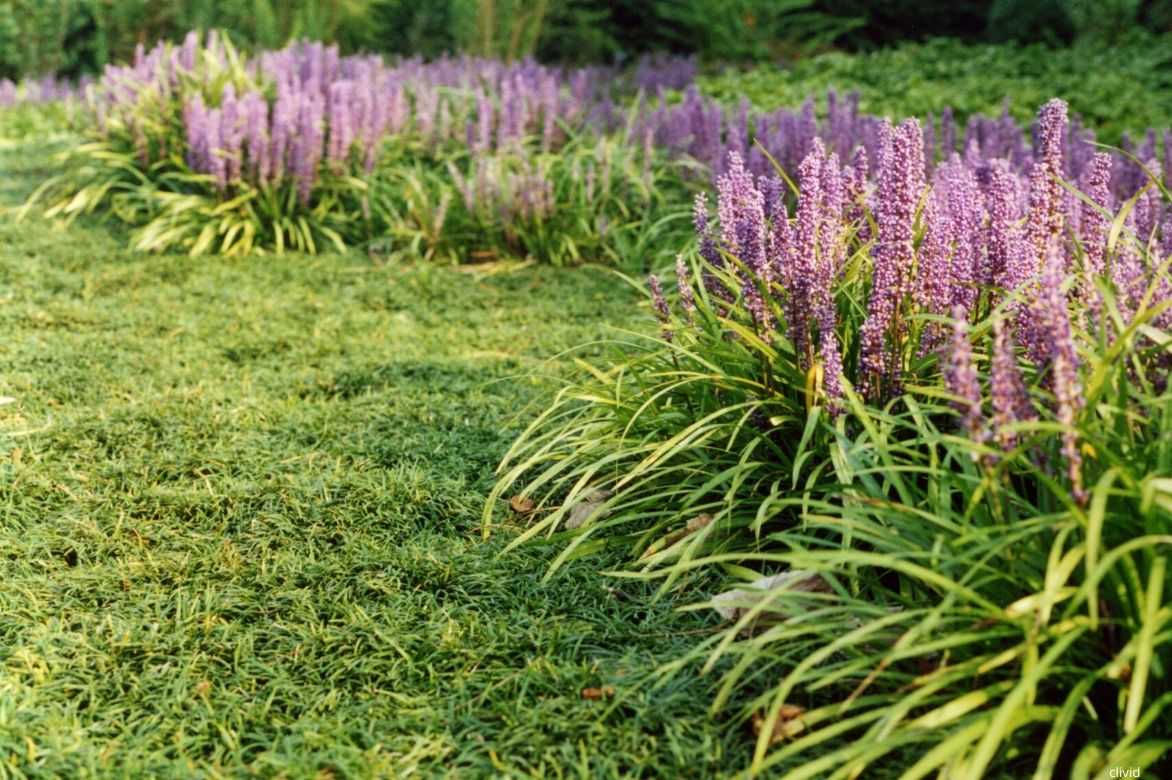
Beautiful mass effect with waves of Liriope muscari
Heavily visited by butterflies and bees, after pollination, these tiny bells produce fleshy green berries that turn purple-black at maturity, measuring 6 to 7 mm in diameter, and self-seed very easily.
Very hardy, tolerating temperatures down to -20°C, Liriope can be grown in all regions. It is a very accommodating plant, requiring almost no maintenance, that thrives in well-drained soil, moderately dry to moist, not too calcareous, in dappled sunlight, partial shade, or even dry shade.
It is an excellent plant for partial shade that will fully serve its role as a groundcover at the edge of a shrub bed, at the foot of deciduous hedges, in cool woodland, in rockeries, to highlight the design of a path, and even in pots on a window or balcony.
Its tuberous root is consumed in Asia in soups or as an accompaniment to rice.
“`
Main species and varieties
Liriope muscari has given rise to numerous cultivars, now offering a wider range of colours and denser flowering.
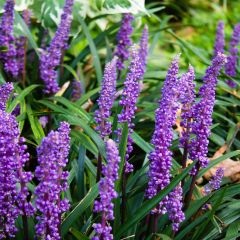
Liriope muscari
- Flowering time September to November
- Height at maturity 30 cm
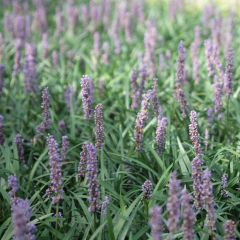
Liriope muscari Ingwersen
- Flowering time September to November
- Height at maturity 35 cm
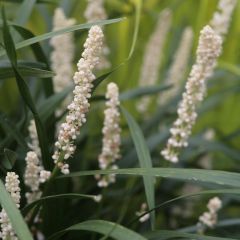
Liriope muscari Monroe White
- Flowering time September to November
- Height at maturity 40 cm

Liriope muscari Gold Banded
- Flowering time August to November
- Height at maturity 30 cm
Discover other Liriope
View all →Available in 2 sizes
Available in 2 sizes
Available in 2 sizes
Available in 0 sizes
Available in 2 sizes
Available in 1 sizes
Available in 1 sizes
Available in 1 sizes
Available in 1 sizes
Available in 1 sizes
Planting
Where to Plant Liriope
Easy to grow and with excellent hardiness (down to -15°C), Liriope thrives throughout France. Once well established, it also offers good drought resistance. While it adapts to any soil, it prefers fertile, well-drained soil that is not too calcareous and slightly acidic. It requires well-drained soil, especially in winter, as its roots suffer from stagnant moisture.
This is a shade and partial shade perennial plant, but it can tolerate light sun, provided the soil remains cool.
Liriope is the perfect groundcover for shaded areas of the garden, bringing lightness and brightness. Versatile, it can be used in many situations. It can be planted in a cool border, in rockeries, or in woodland areas at the base of trees where nothing else grows, or even scattered in lightly mown meadows or in Japanese-style gardens. It blooms in all areas of the garden, including balconies. Its dense root system also helps stabilise soil on slopes or banks and reduces runoff.
It fits in anywhere, between existing plants, filling gaps in borders. Over time, it slowly expands to form large masses of foliage: it will be an excellent alternative to grass in difficult-to-access shady areas of the garden, thus reducing the need for weeding.
When to Plant Liriope
Plant liriope in spring from March to June to enjoy its lovely summer flowering, or in early autumn.
How to Plant Liriope
In the Ground
In calcareous soil, add heather soil or compost. Plant Liriope in scattered clumps or in groups of 7 to 8 plants per square metre spaced 30 cm to 60 cm apart, for a beautiful decorative groundcover effect all year round. In overly clayey soils, incorporate coarse sand or gravel to improve drainage.
- Dig a hole 2 to 3 times wider than the root ball
- Mix the extracted soil with compost
- Plant the root ball and fill in
- Lightly firm the soil
- Water generously
In Pots
Ensure good drainage to prevent moisture from stagnating at the roots.
- At the bottom of the container, spread a good layer of drainage (gravel or clay balls)
- Plant in a mixture of ordinary potting soil, loamy soil, heather soil, and one-third coarse sand
- Water thoroughly
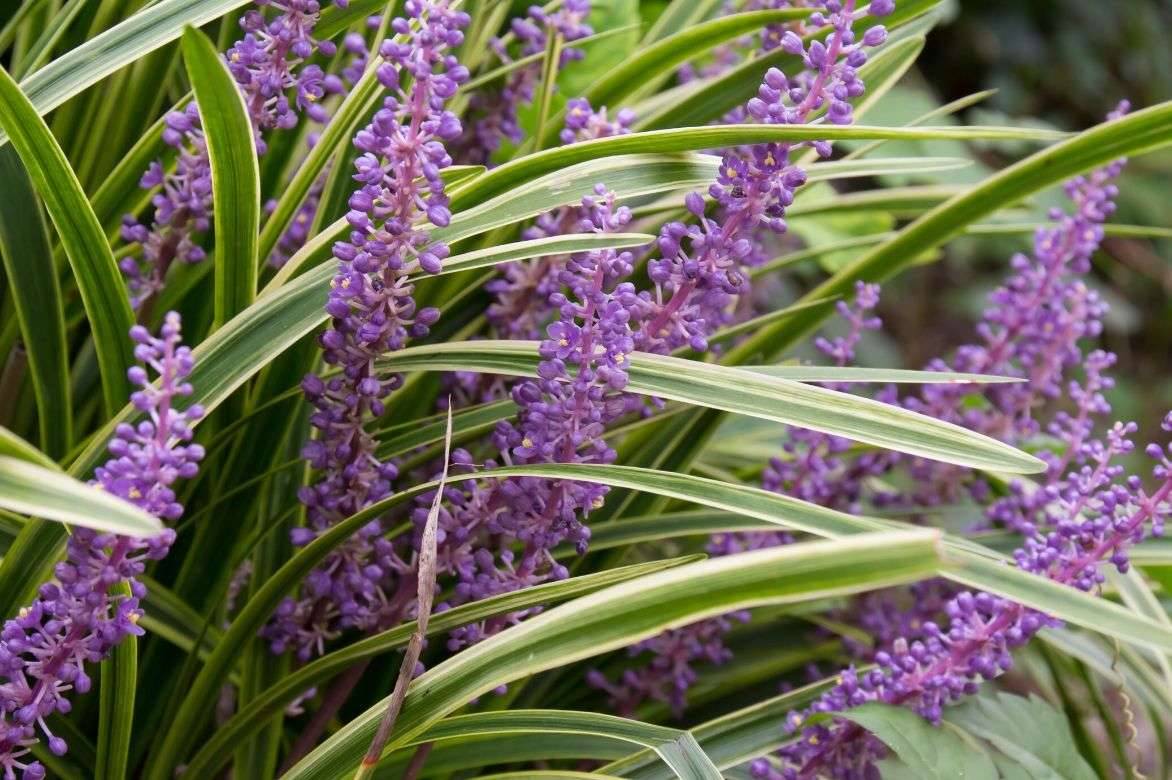 Some Liriopes have variegated foliage… discover the stunning variety ‘Gold Banded’!
Some Liriopes have variegated foliage… discover the stunning variety ‘Gold Banded’!
Read also
10 plants to create a shady rockeryCultivation and Care of Liriope
Once established, Liriope requires very little maintenance. In the first year, provide regular watering but avoid overwatering until it is established. Once well-rooted, it no longer needs watering as it tolerates drought well. It will be more demanding in terms of water if planted in full sun.
In summer, in the driest and hottest regions, water once or twice a month and during prolonged dry spells.
In pots, allow the substrate to dry on the surface between waterings and nearly stop watering in winter.
In autumn, before flowering in any case, you may add decomposed compost by scratching it into the base of the clumps.
Liriope does not require pruning: simply remove the faded spikes.
At the beginning of spring, remove yellowed, dry, and damaged leaves, and clean the clumps to maintain an elegant appearance.
Never sick, Liriope is rarely endangered except in spring by attacks from slugs and snails that love its young leaves. Follow our tips to naturally deter these gastropods or make traps!
Multiplication
The fastest and safest method to propagate liriope is by dividing clumps in spring from well-established plants.
- Lift a few clumps by hand or with a spade, ensuring to take well-leafed sections.
- Immediately replant the taken divisions in well-prepared soil enriched with compost.
Associate Liriope with the garden
The Liriope is a discreet yet elegant plant, suitable for multiple uses that bring lightness to the garden. It slowly covers the neglected shady areas of the garden. It is essential in low-maintenance gardens, where it forms year-round carpets of evergreen leaves without requiring attention or watering. With its pastel flowering, it thrives in many situations as a flowering carpet, at the edge of woodlands at the base of trees, scattered in the lawn, to dress a pathway border or a shaded rockery, or even in Japanese-style gardens around the base of a Japanese maple.
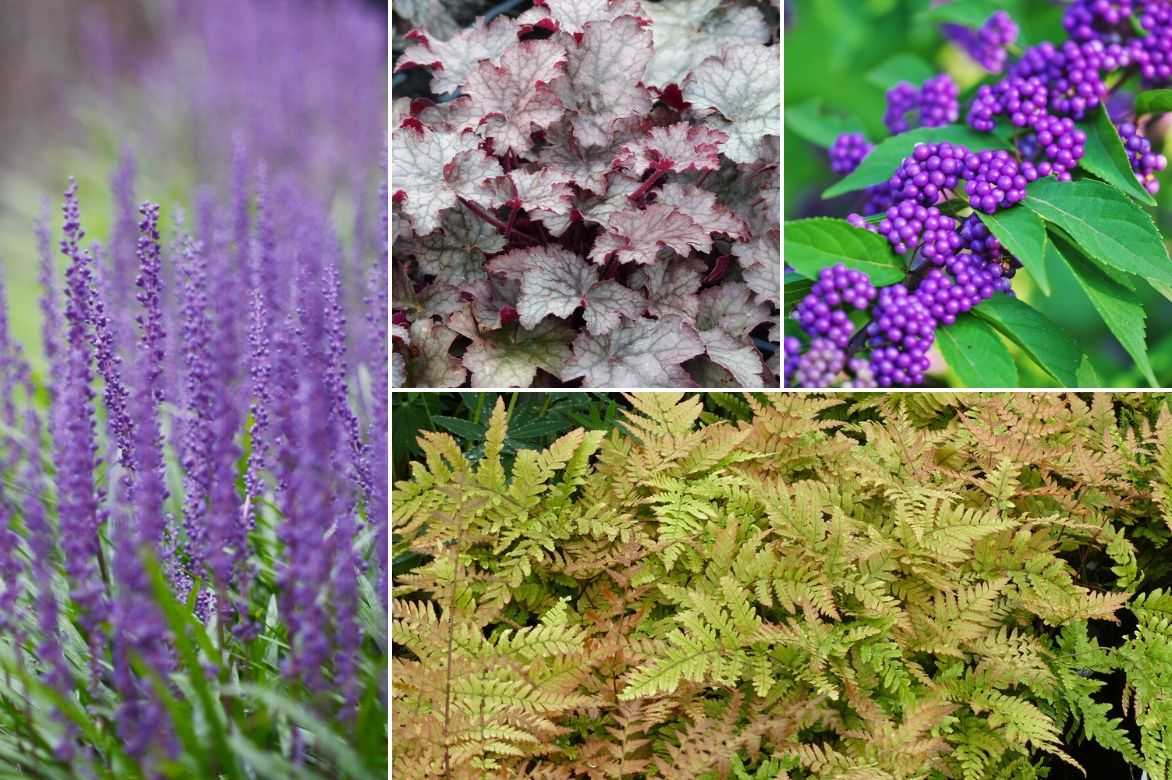
An example of association: Liriope muscari (the variety ‘Ingwersen’ for example), Heuchera ‘Amethyst Mist’, Dryopteris erythrosora under the cover of a Callicarpa bodinieri ‘Profusion’
At the heart of a bed of heather soil shrubs, alongside heathers, it will also dress the base of hydrangeas, rhododendrons, and magnolias.
It is the essential groundcover to bring brightness to the shaded and cool areas of a shade garden alongside small spring bulbs (muscaris, snowdrops, botanical daffodils…)
In woodlands or rockeries, it will naturally blend with other shade-loving groundcover perennials such as hostas, pachysandra, Geranium macrorhyzum ‘Olympos’, Hepatica nobilis ‘Red Forest’, bergenias, epimediums, vinca minor, heucheras which are all equally easy and accept the same growing conditions.
Useful resources
- Find our tips on growing liriope in pots
- What to plant under trees?
- Creating a shady border: which plants to choose?
- Shade in the garden: all our ideas!
- What to plant under a tree?
- Learn more about perennials with decorative fruits
- Subscribe!
- Contents
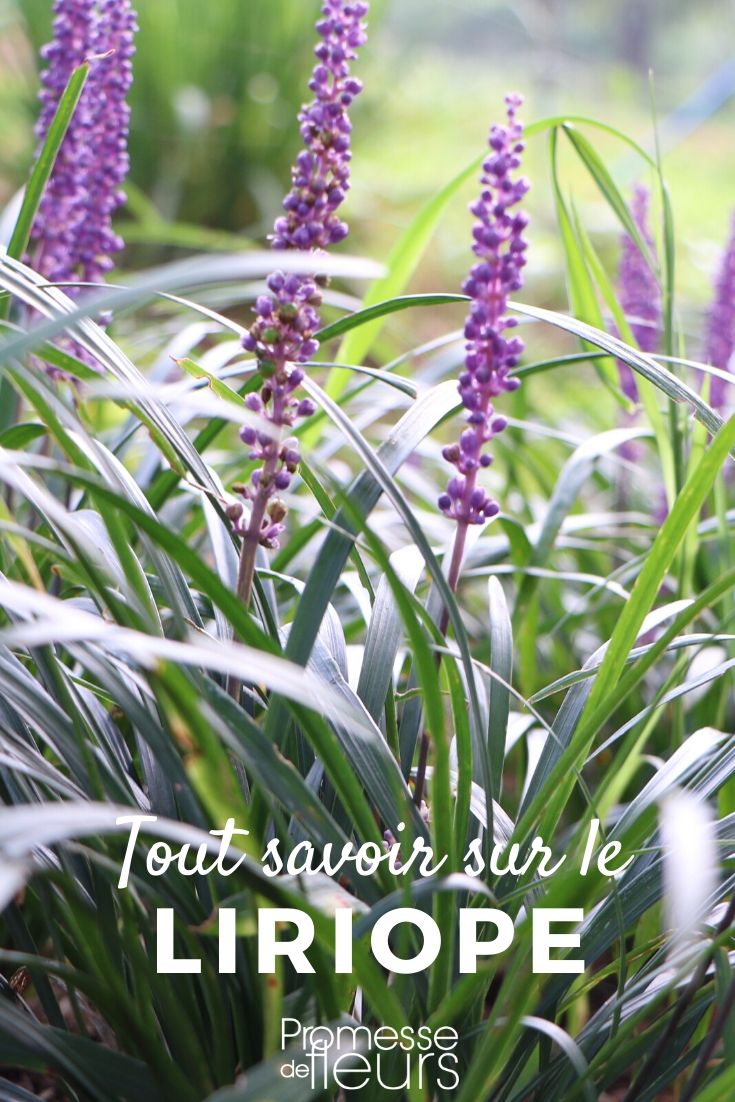


































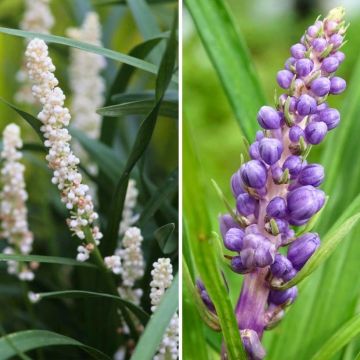


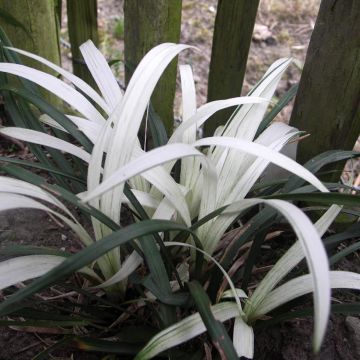
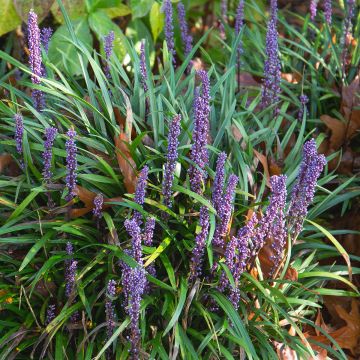
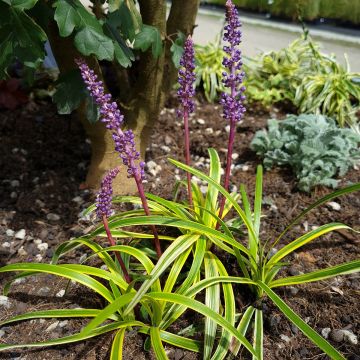
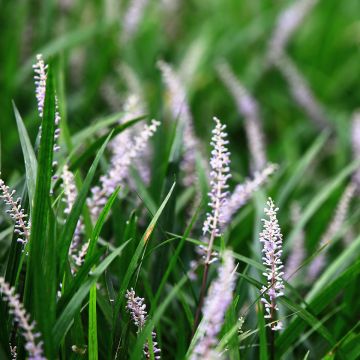
Comments